First of all, here’s a simple diagram of a typical Hermann’s tortoise outdoor enclosure.
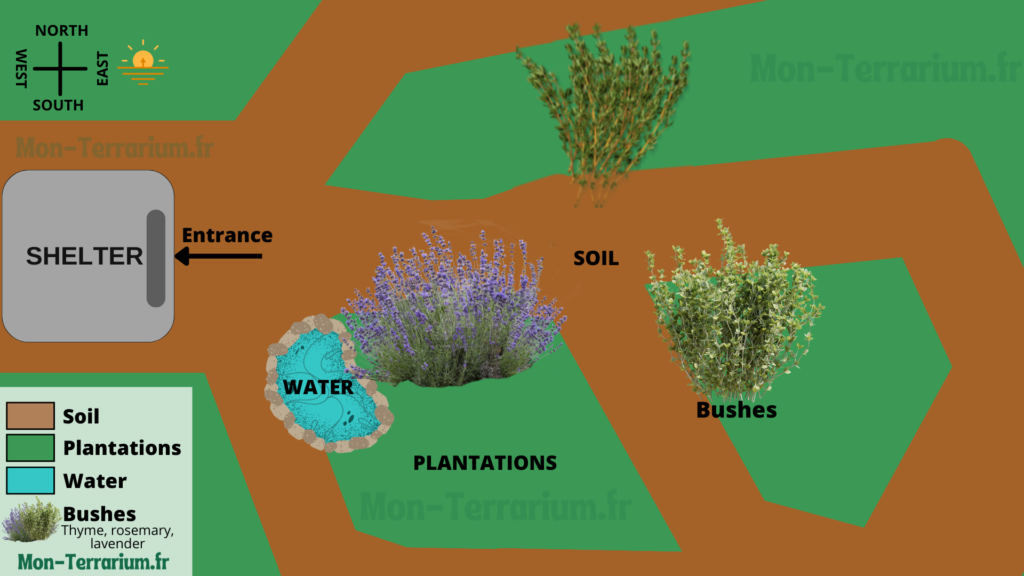
Hermann’s tortoise is a wild reptile, just like the graeca tortoise, or any other land tortoise. It is therefore essential to prepare a customized enclosure that respects its original environment. In this case, Hermann’s tortoises originate from the Mediterranean Sea, in southeastern Europe, in relatively warm regions compared with the north.
The terrestrial turtle therefore requires a fairly large outdoor enclosure, ideally at least 3×3 meters, as it likes to roam. If you have a garden, this is perfect. However, if you have a large balcony or yard, you can still install an enclosure.
Indeed, it’s essential that your turtle lives outdoors, unless it’s still a juvenile (under 3 months old), in which case it can stay in a terrarium or indoor enclosure.
Let’s take a look at the most important points to consider when building an enclosure for your Hermann tortoise.
Sommaire
- 1 Building a Hermann tortoise enclosure in 9 steps
- 1.1 The location of your tortoise enclosure
- 1.2 Enclosure dimensions
- 1.3 Soil inside the enclosure (substrate)
- 1.4 Choosing a shelter for a tortoise enclosure
- 1.5 What to feed your tortoise?
- 1.6 A watering hole in your tortoise’s enclosure
- 1.7 Shrubs and shade in the enclosure
- 1.8 Protecting your Hermann’s tortoise from predators
- 2 Juvenile tortoise: enclosure or terrarium?
- 3 Turtoise enclosure to build : examples
- 4 Conclusion
Building a Hermann tortoise enclosure in 9 steps
Planning the construction of a secure land tortoise enclosure for your turtle(s) can be a real challenge for new breeders. We’ve put together a list of criteria and tips to consider when planning your enclosure!
In this comprehensive guide, we’ll look at the 10 most important points for a quality enclosure that your animals will love.
The location of your tortoise enclosure
The location of your land tortoise’s enclosure plays an important role in its well-being. It needs to be located in the sunniest part of your garden or terrace, so that the sun can flood the area. Generally, this is south-west, but it’s up to you to determine the ideal area.
Your turtle likes warmth, and needs the sun’s UVB rays for proper development. So avoid placing the enclosure close to obstacles that could create a shady area or obstruct the sun’s rays in any way. However, try to protect the enclosure from the wind, as a chill can quickly set in.
South-facing is best for maximum sunlight
Finally, if you can also keep it out of the public eye, all the better, as turtle thefts unfortunately do happen.
Enclosure dimensions
The best advice we can give: as large as possible. This enclosure is your tortoise’s home. Who wouldn’t prefer 150m² to a 20m² studio?
Turtles need space because they like to walk and roam, and the garden can easily be adapted to accommodate them. For a single adult Hermann tortoise, you’ll need an enclosure measuring at least 2 x 2 meters.
For 2 turtles, consider an enclosure of 3m x 4m or more. Finally, if you have juvenile or young turtles, you can start with 1m x 2m minimum and enlarge the enclosure as they grow.
How do I set up my tortoise enclosure?
We’re going to spend a little more time on what needs to be present in your tortoise’s enclosure, but here’s the general idea.
You’ll need to set up :
- Areas for basking in the sun.
- Shady areas, with generous shrubbery.
- A shelter to sleep in warmth, and to hibernate if necessary.
- A water area for drinking.
- A fence around your enclosure to prevent your turtle from escaping.
- An irregular relief all along the fence, but not only, including :
- Bumps and slopes (with substrate) to better target the sun.
- Areas with more grass and planting.
- Stones for clawing and warmth.
In particular, this will help your turtle get back on its feet if it rolls over.
Fencing your tortoise enclosure
Fencing your turtle’s enclosure is essential if you don’t want it to run away. You’ll need a wooden fence over 30 centimetres high, and wire mesh 20 to 30 centimetres deep around the enclosure.
As happy as she may be, Hermann’s tortoise is an adventurer who loves short or long escapades. So she won’t hesitate for a moment to head off to greener pastures. Don’t underestimate your tortoise’s ability to dig and climb – you’d be shocked.
Personally, I recommend this 40-centimeter-high wooden fence, and this chicken wire for burying around your enclosure (don’t use it as a surface fence).
Soil inside the enclosure (substrate)
If you have a garden, the soil in it will do just fine. If you don’t (terrace, balcony, courtyard), I recommend dark earth as a substrate or “soil”, to grow plants and absorb the sun’s heat.
As you can see from the diagram at the top of this guide, the enclosure should be made up of zones with and without herbs, as well as others with shrubs. You’ll need to grow (or plant) grass and shrubs in your tortoise’s enclosure.
Heather soil, universal potting soil or coconut fiber potting soil do the trick.
La terre de bruyère, le terreau universel ou le terreau en fibre de coco font très bien l’affaire.
Choosing a shelter for a tortoise enclosure
There are a number of ways to create a shelter or “hiding place” for your tortoise. This will enable your turtles to protect themselves from the cold or the sun, and to hibernate in winter.
- Make a cave with stones and cover it with earth. The inside should be filled with hay or dry, rot-resistant leaves such as oak, beech, maple or plane.
- Use a concrete manhole with a removable roof, and cover it with soil. You can easily find these in DIY stores, and enlarge the entrance to avoid damaging your turtle’s shell. For the inside, you can also use hay and dead leaves that won’t rot.
- Use a ready-made enclosure (wood, plastic or other). Once again, you can cover it with soil, and line the inside with the same dry vegetation. This is an ideal solution if you’re not too handy. However, you can easily enlarge the entrance if it’s too small for your turtles.
Here are a few shelters that do the trick:
What to feed your tortoise?
As you can see from the diagram of the enclosure, it’s a good idea to sow basic edible plants and vegetables directly, so that your turtle can eat when it needs to. If you plant the plants listed above in early spring, you’ll see them grow quickly, and your tortoise will feed on them just as quickly.
Here’s a non-exhaustive list: lamb’s lettuce, bindweed, turnips, radishes, althea, dandelions, plantains, clovers, pansies, daisies, nasturtiums, goosefoot, alfalfa, vetch, sedums and bluebells.
In addition, you can feed your turtles with other plants, fruits, vegetables or mixtures purchased online, such as these, which my tortoises love:
A watering hole in your tortoise’s enclosure
For the good of your tortoise, it is necessary to place a water point in its enclosure. This should be large enough and deep enough for your turtle to bathe in, but not so deep that it can submerge itself completely, as it could drown.
As far as hygiene is concerned, we recommend using an accessible water tray or bowl, and changing the water regularly to prevent the development of bacteria.
Shrubs and shade in the enclosure
In hot weather, turtles like to seek shade behind shrubs and small bushes in their enclosure. Thyme, rosemary, lavender and strawberry bushes are non-toxic and do the trick. What’s more, you can use them in cooking, for decoration, and for their fragrance!
Protecting your Hermann’s tortoise from predators
Juvenile turtles and those whose plastron and carapace are not strong enough fear predators (birds, rodents, chickens and pets). So it’s essential to cover their enclosures with wire mesh.
I recommend mesh that can be easily removed for easy access to the enclosure. Here are a few that work very well:
Juvenile tortoise: enclosure or terrarium?
Generally speaking, an enclosure is always preferable, as it best reproduces the turtle’s natural environment. However, for the first months or year of your turtle’s life, you can place it in a terrarium or indoor enclosure. This will ensure her safety, as she is quite fragile as a juvenile.
You can also keep her indoors if she hasn’t been able to hibernate, or if she’s woken up but the outside temperatures are too low.
Finally, you can also keep her in a terrarium temporarily if she’s ill, or if you haven’t finished building the enclosure. If that’s the case, here’s the best indoor enclosure (and the second best) in my opinion, and I’ve even written my feedback on it:
Turtoise enclosure to build : examples
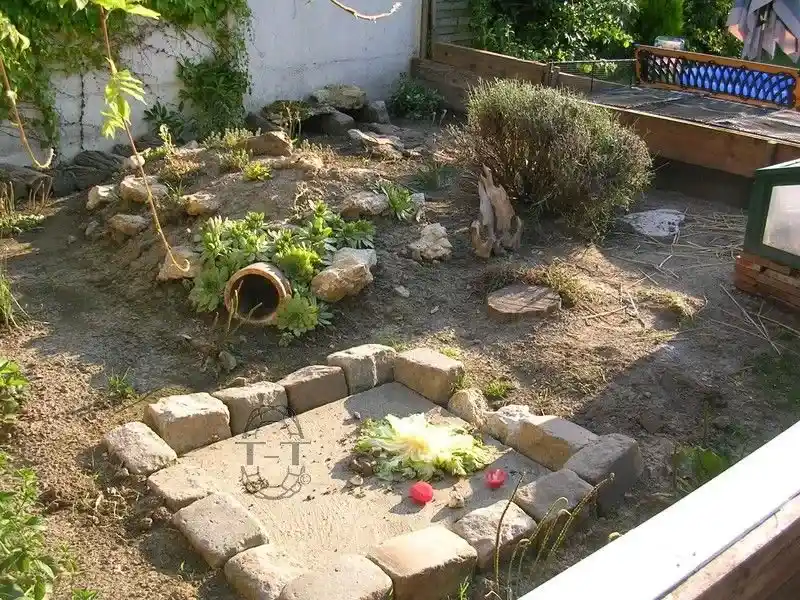
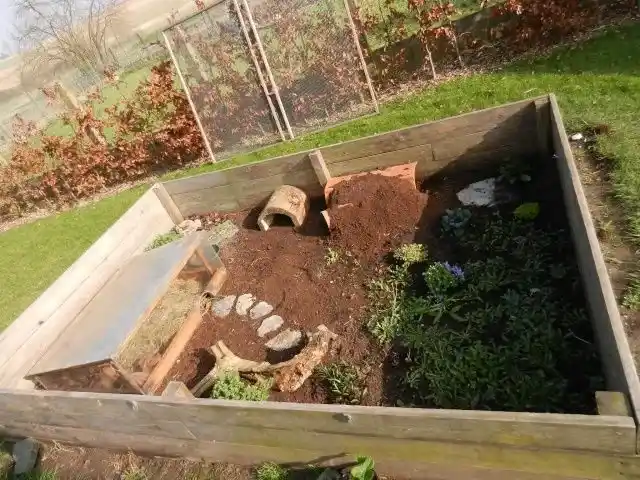
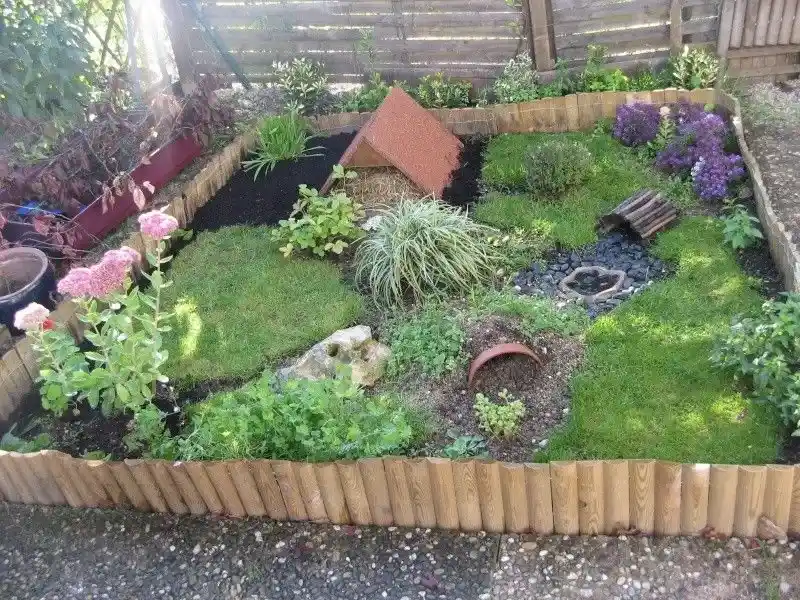
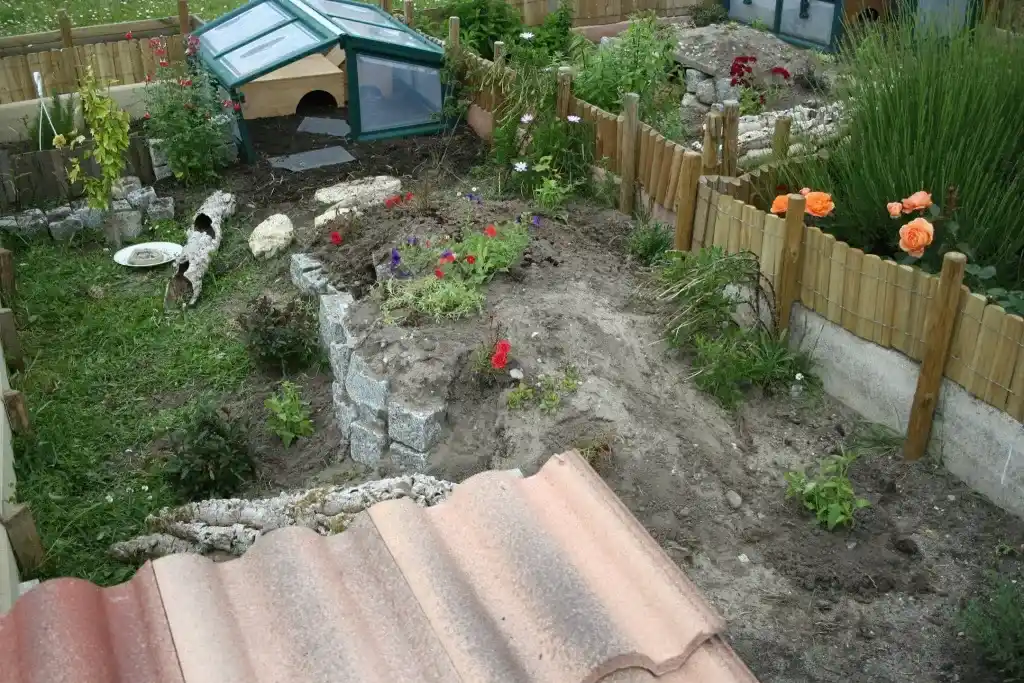
Conclusion
As you can see, accommodating a land tortoise such as the hermann’s tortoise or the greek tortoise in an enclosure requires some planning. Between the dimensions, the planting, the shelter (the hut) and the hiding places, you need to get organized and get your hands dirty. In the end, however, nothing too complicated.
As for hibernation, and other guides for hermann tortoises, you can find them in the land tortoise section of Mon-Terrarium. And if you have any questions about this article, post them in the comments section – I always answer them!
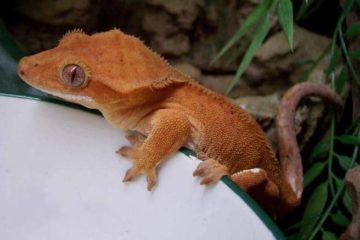
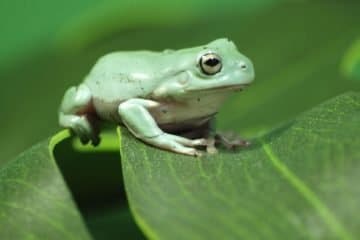
0 Comments